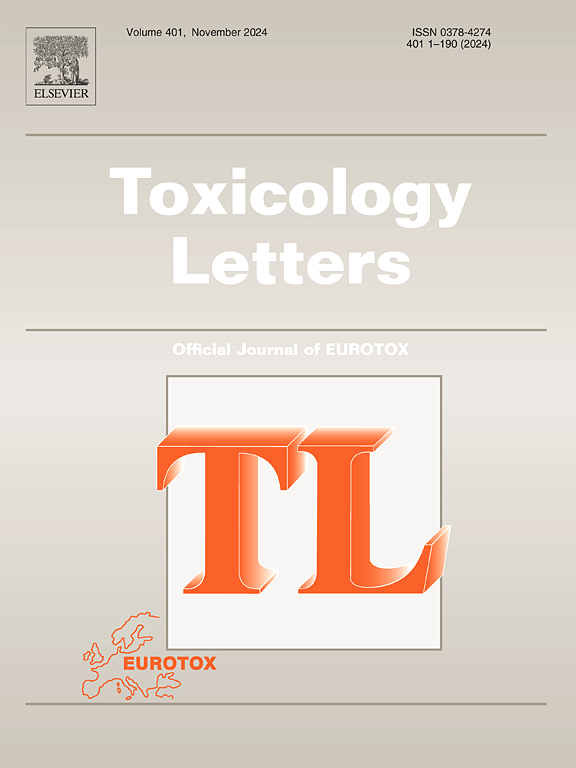Harmful beauty – Temporal profile of urinary phthalate metabolites in tattooed volunteers from Slovakia
IF 2.9
3区 医学
Q2 TOXICOLOGY
引用次数: 0
Abstract
Tattoos are becoming increasingly popular, but tattoo inks often contain harmful chemicals such as phthalates, which are endocrine disruptors. The study aimed to biomonitoring of phthalate metabolites. Seven tattooed subjects were recruited; 24-hour urine samples were collected over five consecutive days. High molecular weight phthalates (HMWP) and low molecular weight phthalates (LMWP) were analyzed using high-performance liquid chromatography-tandem mass spectrometry (HPLC MS/MS), and metabolite profiles were analyzed before and after the tattoo session. Tattoo characteristics and consumer behaviours (CSB) were evaluated. Peak concentrations were observed in 48.94 % of urine samples for LMWP and 47.27 % for HMWP, particularly on or after the tattoo day. Mono-hydroxy-iso-nonyl phthalate (OH-MiNP) concentrations were significantly higher in subjects with colored tattoos (p = 0.029). A positive correlation was observed between mono-iso-nonyl phthalate (MiNP) and tattoo size (r = 0.875, p = 0.010). OH-MiNP (r = 0.759, p = 0.048, Day 1), mono(2-ethylhexyl) phthalate (MEHP, r = 0.767, p = 0.044, Day 5) and mono(2-ethyl-5-carboxypentyl) phthalate (cx MEPP, r = 0.755, p = 0.05, Day 5) were associated with CSB. Tattooing could be a potential source of phthalate exposure, tattoo size, and ink color could play a role. The small sample size of subjects may have influenced the possibility of false positive results.
有害的美——斯洛伐克纹身志愿者尿液邻苯二甲酸酯代谢物的时间谱
纹身越来越受欢迎,但纹身墨水通常含有有害化学物质,如邻苯二甲酸盐,这是内分泌干扰物。本研究旨在对邻苯二甲酸酯代谢物进行生物监测。招募了7名有纹身的受试者;连续5天采集24小时尿液样本。采用高效液相色谱-串联质谱(HPLC /MS)分析高分子量邻苯二甲酸酯(HMWP)和低分子量邻苯二甲酸酯(LMWP),并分析纹身前后代谢产物谱。对纹身特征和消费行为(CSB)进行评价。在48.94% %的尿液样本中观察到LMWP的峰值浓度,47.27% %的尿液样本中观察到HMWP的峰值浓度,特别是在纹身当天或之后。邻苯二甲酸单羟基异壬基酯(OH-MiNP)浓度在彩色纹身受试者中显著较高(p = 0.029)。邻苯二甲酸单异壬基酯(MiNP)与纹身尺寸呈正相关(r = 0.875,p = 0.010)。OH-MiNP (r = 0.759,p = 0.048,第一天),mono (2-ethylhexyl)邻苯二甲酸二(MEHP, r = 0.767,p = 0.044,第五天)和mono (2-ethyl-5-carboxypentyl)邻苯二甲酸二(cx MEPP, r = 0.755,p = 0.05,第五天)与CSB有关。纹身可能是邻苯二甲酸盐暴露的潜在来源,纹身的大小和墨水的颜色都可能起作用。受试者的小样本量可能影响了假阳性结果的可能性。
本文章由计算机程序翻译,如有差异,请以英文原文为准。
求助全文
约1分钟内获得全文
求助全文
来源期刊

Toxicology letters
医学-毒理学
CiteScore
7.10
自引率
2.90%
发文量
897
审稿时长
33 days
期刊介绍:
An international journal for the rapid publication of novel reports on a range of aspects of toxicology, especially mechanisms of toxicity.
 求助内容:
求助内容: 应助结果提醒方式:
应助结果提醒方式:


